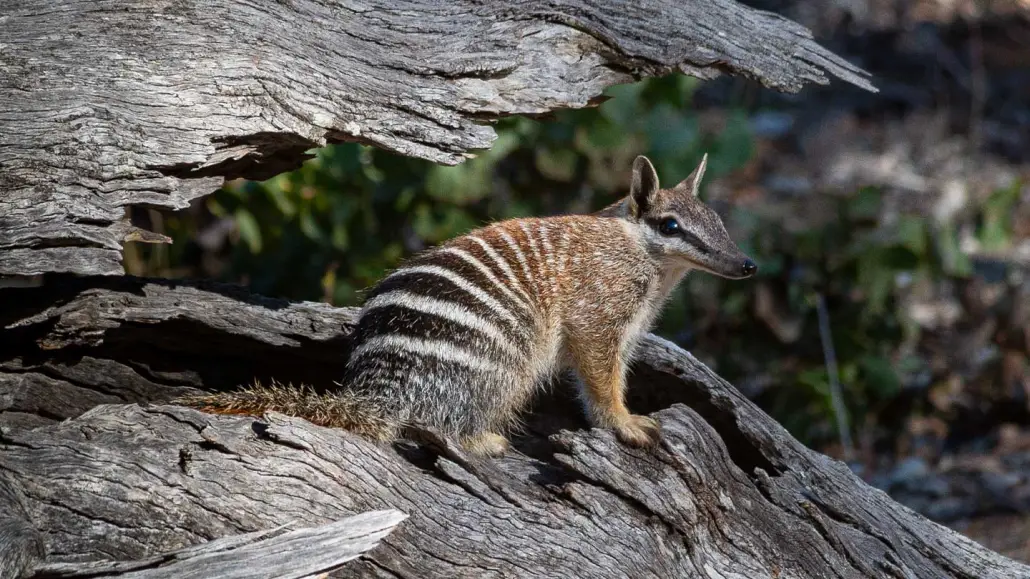
Numbats (Myrmecobius fasciatus) (one shown) feed only on termites, which come to the surface in heat of the day.
Christine Cooper
Numbats are curious creatures. The only marsupials that are active solely during the day, when they scratch at soil and rotting logs for termites, these squirrel-sized animals are built to hoard body heat. But that same energy-saving trait may put the already endangered animals at risk as the climate warms, a new study suggests.
Already, even brief sun exposure on days over 23° Celsius (73° Fahrenheit) can severely limit the time the Australian marsupials can spend foraging, researchers report January 11 in the Journal of Experimental Biology. Numbats might rapidly overheat in the sun, even at relatively reasonable temperatures, the team finds.
“Climate change means that numbat habitats are becoming hotter and drier, with more extreme heat-wave events,” says Christine Cooper, an environmental physiologist at Curtin University in Perth, Australia. She and her colleague — Philip Withers at the University of Western Australia, also in Perth — wanted to know how higher temperatures might impact the animals, and what that might mean for the numbats’ future conservation.
Numbats (Myrmecobius fasciatus) once ranged across much of the southern half of Australia, but wild individuals are now limited to a handful of small populations in the western part of the country. Habitat loss coupled with introduced cats and red foxes continue to imperil the marsupials, and the species is now considered endangered by the International Union for Conservation of Nature.
Add in climate change, and the animals may be increasingly caught between a rock and a hot place: They exclusively eat termites and can forage only during the day when their prey is active. Termites make for a low-cal diet, so the marsupials are adapted to maximize heat gain to save energy they’ll need in cooler temperatures, Cooper says.
To measure in detail how numbats’ bodies heat up in varied environmental conditions, the researchers slowly drove around two nature reserves near Perth, recording numbats’ surface temperature using a thermal imaging camera fitted with a telephoto lens. Over 2020 and 2021, the team recorded numbats with the thermal camera on 50 occasions. Of those numbat sightings, 62 percent were spotted in the sunshine. The recordings showed that the surface temperature of some body regions of a numbat can increase to 35° C or more, suggesting the animals rapidly heat up in the sun.
Using environmental and body temperature data from the thermal images, the researchers then calculated how much, and how fast, a numbat might heat up. When temperatures exceed 23⁰ C, numbats may brave the sun in only short stints, maybe about 10 minutes, before reaching a core body temperature of 40⁰ C, the maximum body temperature ever recorded for an active numbat, Cooper says.
Ducking into the shade when the heat gets too intense isn’t a perfect solution, the team found.
Based on the team’s calculations, only about 18 percent of the heat numbats absorbed came directly from the sun itself. Heat from the hot air and radiating from the ground also warmed the animals. In increasingly hot conditions caused by climate change, even the shade might become too hot for numbats to properly function and might make it difficult for them to hunt their termite prey, though it is not clear how much these animals, compared with others, can adapt to rising temperatures (SN: 7/11/14).
Numbats might be able to shift their foraging to earlier and later in the day. But “if temperatures become too extreme, numbats might not have sufficient time to forage during daylight, and it is unlikely that they can survive when foraging at night,” Cooper says. Once night falls, the termites retreat deeper underground and out of reach, and the numbats face additional exposure to native and non-native predators alike.
A key next step would be to see how a loss of termite hunting ability from extreme heat impacts numbats’ survival or reproduction, says Eric Riddell, a global change biologist at the University of North Carolina at Chapel Hill. In doing so, “we can actually draw more direct associations between how hot the animal gets and its ability to survive.”







